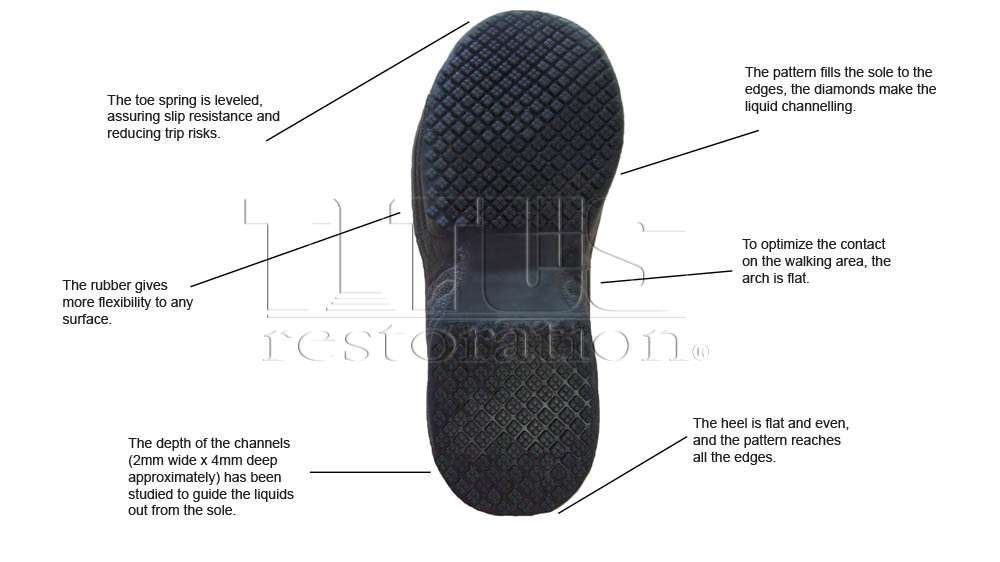The structural anatomy of oil and slip resistant shoes is important (or work boots, steel toe and others as well). Since footwear is the second leading cause of slips and falls, it is important to understand what the significant features are when developing a safety footwear program for your work place, industrial facility, factory, or warehouse. Oftentimes, oil and grease are part of the problem and other times water from floor maintenance (or sweating slab syndrome) is a contributing factor.

We recommend Slip Resistant Shoes as the first defense against oily, slippery, or wet floors suffering from sweating slab syndrome.
Sole Material Rated Against a Walking Surface
The material the shoe’s soles are made of is important and it’s also important to rate them against a walking surface to have a clear idea about your choice.
In the following table you can check sole material recommendations for a specific floor and then compare the slip resistant shoes that better suit your needs.
By clicking the “+” icon additional information is available.
| Sole Material | Tile (dry) | Tile (wet) | Wood (dry) | Concrete (dry) | Concrete (wet) |
|---|---|---|---|---|---|
| Neoprene | Recommended | Recommended | Recommended | Recommended | Recommended |
| Crepe | Not Recommended |
Not Recommended |
Not Recommended |
Recommended | Recommended |
| Leather | Recommended | Recommended | Recommended | Not Recommended |
Recommended |
| Soft Rubber | Recommended | Not Recommended |
Not Recommended |
Recommended | Recommended |
| Soft Rubber | Not Recommended |
Not Recommended |
Recommended | Not Recommended |
Recommended |
Data Sources: Mekeel and Falls Aren’t Funny, by Russell J. Kendzior (2010)
Material Qualities for Appropriate Choice for Slip Resistant Shoes
It is important to have soles that channel the water from under the shoe. Shoe soles that have large, un-patterned or circular patterns may cause hydroplaning beneath the shoe and cause the wearer to slip or fall. Over time, all shoe soles wear out so all industrial footwear programs should contain a provision for regular replacement of slip resistant footwear.
Qualities of Various Shoe Sole Materials
When you are considering to purchase new slip resistant shoes , you should evaluate their material composition, and how they behave against abrasion, chemicals, cement, water slide, water and oil.
Carefully comparing the features you require and the materials available you can choose the non slip shoes for your safety footwear program saving money and time.
| Sole Material | Abrasion | Chemical | Cement | Slipping | Water | Oil |
|---|---|---|---|---|---|---|
| Vibram | Excellent | Good | Excellent | Excellent | Excellent | Good |
| Leather | Fair | Fair | Good | Good | Not Recommended | Fair |
| Neoprene | Excellent | Excellent | Excellent | Good | Excellent | Excellent |
| Neo Crepe | Good | Fair | Good | Excellent | Good | Good |
| Rubber Vulcanized | Excellent | Good | Excellent | Good | Excellent | Good |
| Rubber Nitrile | Excellent | Excellent | Excellent | Excellent | Excellent | Excellent |
| Polyurethane | Excellent | Excellent | Excellent | Good | Excellent | Excellent |
Data Sources: Canadian Centre for Occupational Health (1999b) and Safety and Falls Aren’t Funny, by Russell J. Kendzior (2010)
